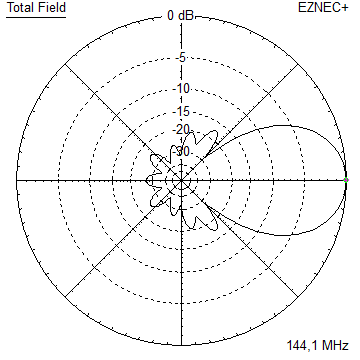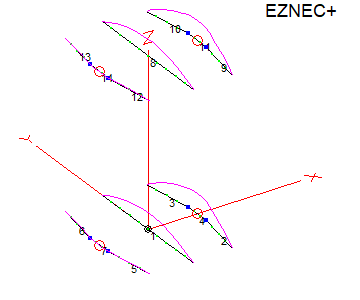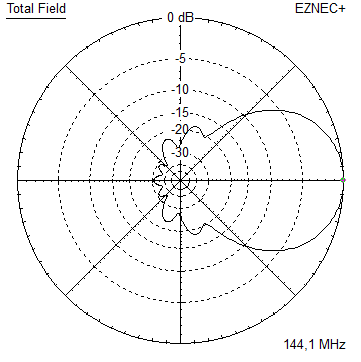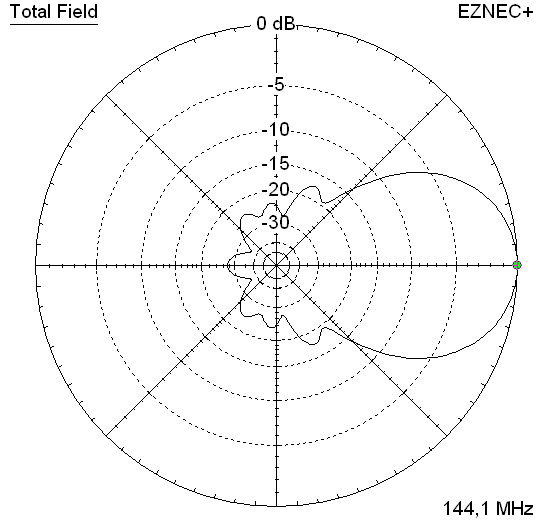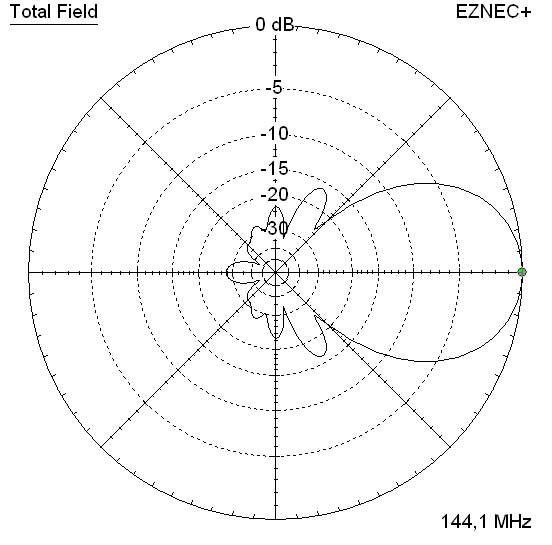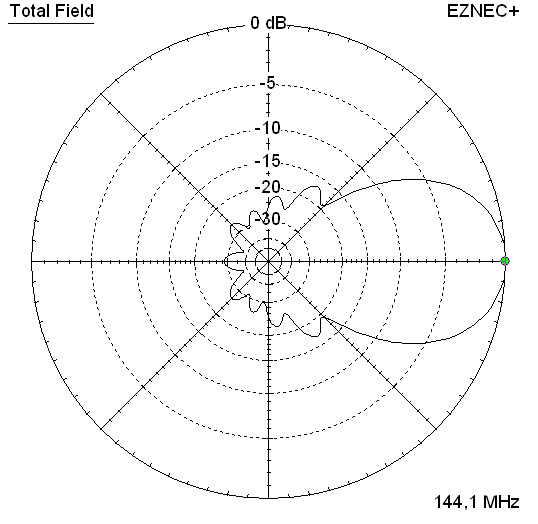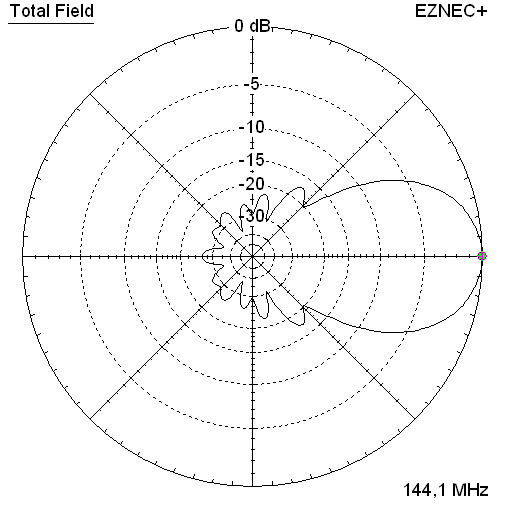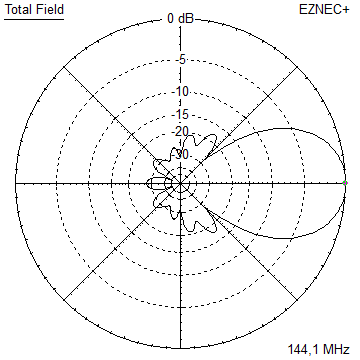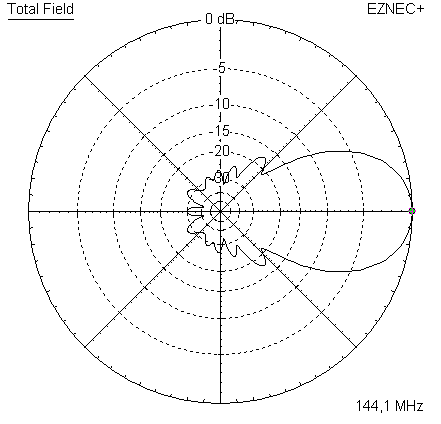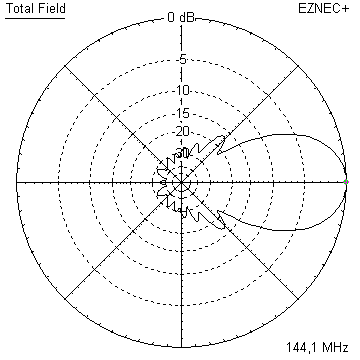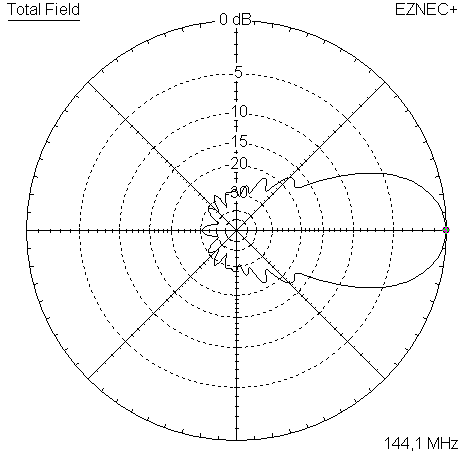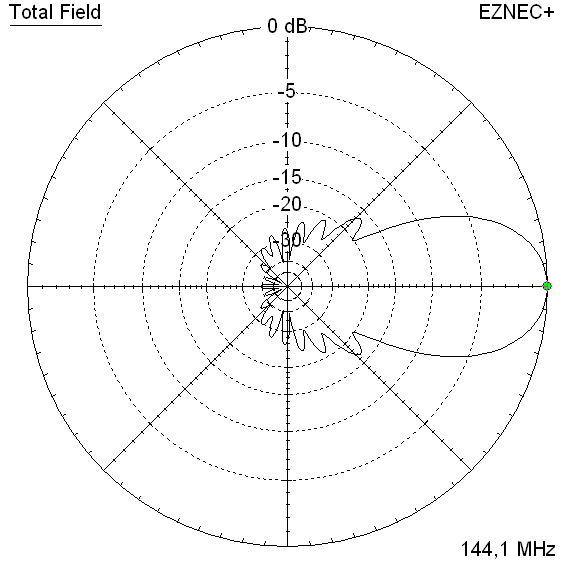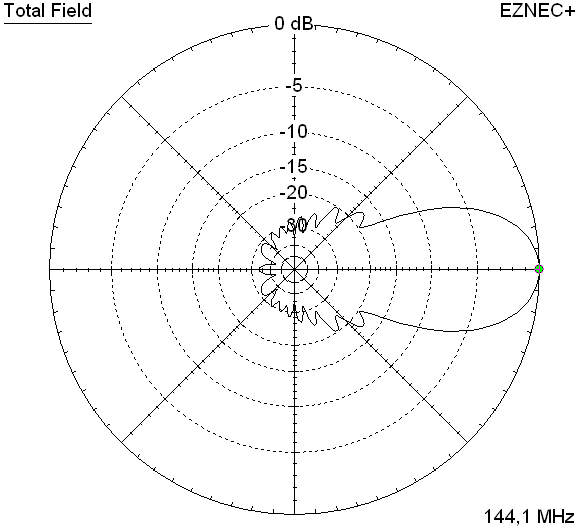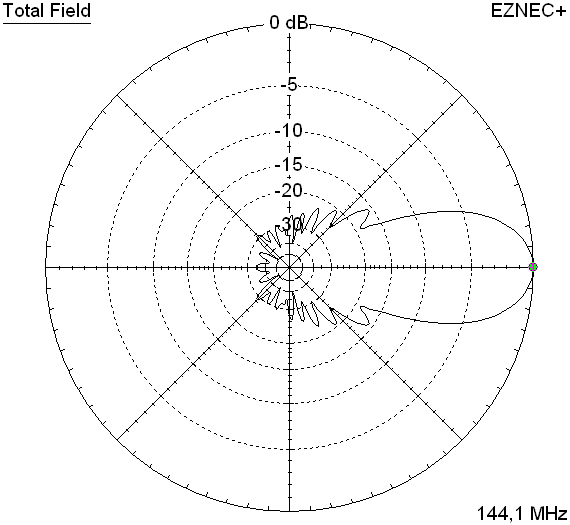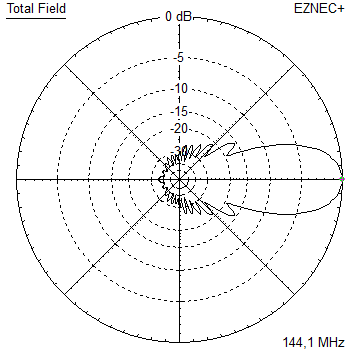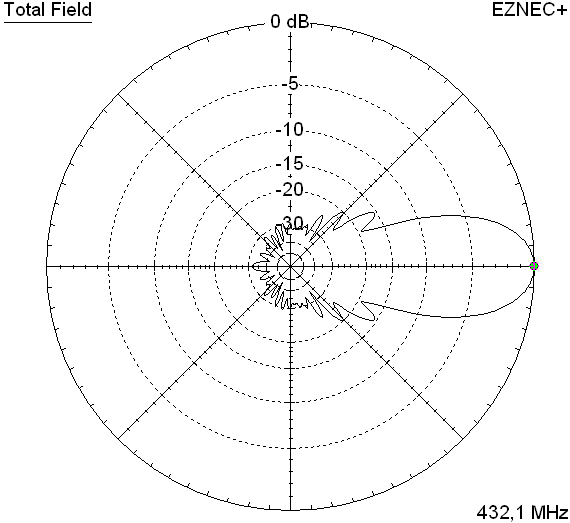
GTV 2-2m Yagi with bent Driven Element
This tiny Yagi shows the typical advantage of using a bent dipole of K6STI style, here once again in DG7YBN modified style with a straight inner part. The rear lobes are a bit more suppressed as with a standadr 2 element Yagi and gain is just a twitch higher. quite a low Antenna Temperature and a moderate gain for its length, which altogether leads to a good G/T number. It may serve as a contest stack or post stamp size EME 4-Yagi-Bay. Which may be useful especially under tough receiving conditions. The bent DE (K6STI style) transforms to 50 ohms at feed point for direct feed. Design date of issue: 2018.08.09

Performance Data single Yagi
Specs: with 8 mm elements @ 144.1 MHz
Gain vs. isotr. Rad. 6.4 dBi Gain vs. Dipole 4.2 dBD -3 dB E-plane 71.2 deg. -3 dB H-plane 134.0 deg. F/B -10.1 dB F/R -6.4 dB Impedance 50 ohms VSWR Band Width 1.06:1 * Mechan. Length 410 mm plus boom ends offset Electr. Length 0.19 λ Stacking Dist. h-pol. top-to-bottom 1.2 m or 3.9 ft ** side-by-side xx m or xx ft *) as in VE7BQH G/T table = at 145.00 MHz **) needs adapted geometry
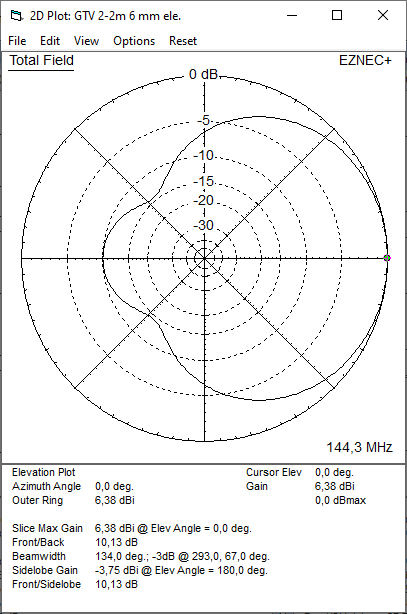 :
: 


Tomas: "I ended up with the dipole dimensions: Straight part 100+100 and bent part 373+373 in length."
Stacking distance: 1200mm.
Distance 401mm dipole (straight part)-reflector, distance R-DE 353mm when using stacked 2el antennas.
Distance dipole tips to reflector is 280mm.
Performance Data, 2 vert. stack
Specs: with 6 mm elements @ 144.3 MHz
Gain vs. isotr. Rad. 10.1 dBi Gain vs. Dipole 8.0 dBD -3 dB E-plane 72.4 deg. -3 dB H-plane 49.0 deg. F/B -21.5 dB F/R -16.8 dB Impedance 50 ohms VSWR Band Width 1.17:1 * Mechan. Length 410 mm plus boom ends offset Electr. Length 0.19 λ Stacking Dist. h-pol. top-to-bottom 1.2 m or 3.9 ft ** side-by-side xx m or xx ft *) as in VE7BQH G/T table = at 145.00 MHz
 :
: 
2 x GTV 2-2m back-to-back built by Tomas, OH6NVQ

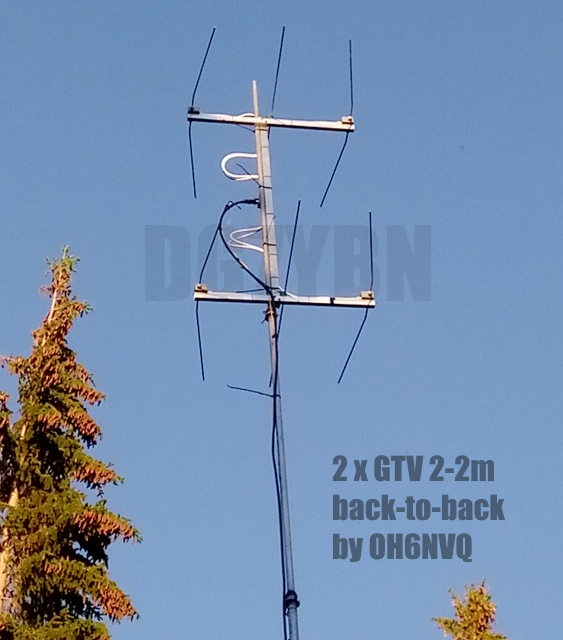
6mm Al rod.
Centerpiece DE 200mm to the bends, bent members l=379mm
REF 1017mm
DE-REF centerpiece distance 353mm.
DE tips-REF distance 285mm.
Shows the same good matching >25dB RL, as the single direction version.
Some building details as images:



Performance Data
Specs: with 8 mm elements @ 144.1 MHz
Gain vs. isotr. Rad. 10.2 dBi Gain vs. Dipole 8.0 dBD -3 dB E-plane 46.2 deg. -3 dB H-plane 48.8 deg. F/B -21.1 dB F/R -17.6 dB Impedance 50 ohms VSWR Band Width 1.33:1 * Mechan. Length 2 x 351 mm plus boom end offsets Electr. Length 0.17 λ Stacking Dist. h-pol. top-to-bottom 1.2 m or 3.9 ft ** side-by-side xx m or xx ft *) as in VE7BQH G/T table = at 145.00 MHz
 :
: 
Return Loss (s11) and SWR plots - simulated with 4nec2:

How many VHF operators have been looking up this design since Oct 2021?
Geometry
Ø8 mm Elements - On Boom - Dimensions (BC acc. DG7YBN)

This Yagi with 8 mm elements on a 15 x 15 mm boom with standard insulators

|
Ele. 8.0 mm DE 10 mm Boom 15 x 15 mm |
"Ready to saw and drill" data for mounting elements on boom with BC according DG7YBN for standard insulators as sold by Konni, Nuxcom, WiMo, 7arrays:
Includes an SBC of 2.93 mm

This Yagi with 8 mm elements on a 20 x 20 mm boom with standard insulators

|
Ele. 8.0 mm DE 10 mm Boom 20 x 20 mm |
"Ready to saw and drill" data for mounting elements on boom with BC according DG7YBN for standard insulators as sold by Konni, Nuxcom, WiMo, 7arrays:
Includes an SBC of 2.93 mm

SegmentationBC = +2.93 mm = (144.7 MHz - 144.2 MHz) * 5.85 mm/MHz BaseBC (20x20) = +3.90 mm for semi-insulated on boom Total = +6.83 mm Note: element lengths for Ø 8 mm fit 5/16" too
On Boom 20 x 20 using SP6GWN Insulators which are a bit flatter

SegmentationBC = +2.93 mm = (144.7 MHz - 144.2 MHz) * 5.85 mm/MHz BaseBC (20x20) = +3.90 mm for semi-insulated on boom Add for Ins. = +1.46 mm Total = +8.29 mm Note: element lengths for Ø 8 mm fit 5/16" too
The Drivers diameter is 10 mm for all examples.
The EZNEC model is done with Auto-Segmentation at 400 MHz
This Yagi with 3/8 inch elements on a 1 x 1 inch boom with hydraulic clamps (like Stauff) or SM7DTT insulators

|
Ele. 3/8 inch or 9.53 mm DE 3/8 inch Boom 1 x 1 inch |
"Ready to saw and drill" data for mounting elements on boom with BC according DG7YBN for hydraulic clamps (like Stauff) or SM7DTT insulator:
Includes an SBC of 2.93 mm


Table 2: GTV 2-6m, 4 mm elements through boom:
"Ready to saw and drill" data for mounting elements through boom with BC according SM5BSZ's BC.exe:
Note: with through Boom BC it is important to stick to the boom end offsets given below!
Metric Boom 20 x 20 x 2 mm
|
This table is only valid for: Boom shape: square Boom dim: 20 x 20 mm Wall thickn.: 2.0 mm Holes in boom: 6.0 mm Offset rear: 40 mm Offset front: 40 mm |
|
Note: with through Boom BC it is important to stick to the boom end offsets given below!

Table 3: GTV 2-6m, 4.76 mm elements through boom:
Imperial Boom 1 x 1 inch x 1.6 mm
|
This table is only valid for: Boom shape: square Boom dim: 25.4 x 25.4 mm Wall thickn.: 1.6 mm Holes in boom: 7.5 mm Offset rear: 40 mm Offset front: 40 mm |
Note: with through Boom BC it is important to stick to the boom end offsets given below!

Sketch of Bent Dipole
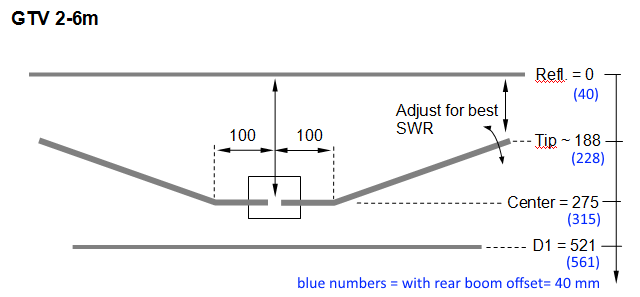
Pattern and VSWR Plots
Elevation and Azimuth plot at 144.1 MHz


RL and SWR plots - simulated


Downloads
EZNEC file of this Yagi with 8 mm elements
xpol Details


General Hints for tuning xpol Yagis
(1) Set up the h-plane only
(2) Tune and plot Return Loss
See to make this single plane work fine, only then proceed.
(4) Add v-plane
(5) Replot h-plane
(6) If h-plane is still fine
(7) Mount the Yagi turned by 90 degr. so that freshly added v-plane is in h
(8) Tune and plot v-plane (in h now)
By measuring and trimming the v-plane in position horizontal we eliminate
possible unknown influences v to h mount for the while being. We would not
like to handle two unkowns at a time.

"Ready to saw and drill" data for mounting elements through boom with BC according SM5BSZ's BC.exe:
Note: with through Boom BC it is important to stick to the boom end offsets given below!
Table 2: GTV 2-6m xpol, 4 mm elements through boom:
Metric Boom 20 x 20 x 2 mm
|
This table is only valid for: Boom shape: square Boom dim: 20 x 20 mm Wall thickn.: 2.0 mm Holes in boom: 6.0 mm Offset rear: 750 / 860 mm Offset front: 150 / 40 mm |
|
Note: with through Boom BC it is important to stick to the boom end offsets given below!

Table 3: GTV 2-6m xpol, 4.76 mm elements through boom:
Imperial Boom 1 x 1 x 1/16 inch
|
This table is only valid for: Boom shape: square Boom dim: 1 x 1 inch Wall thickn.: 1.6 mm Holes in boom: 7.5 mm Offset rear: 750 / 860 mm Offset front: 150 / 40 mm |
Note: with through Boom BC it is important to stick to the boom end offsets given below!

Table 4: GTV 2-6m xpol, 3/8 inch or 9.53 mm elements on boom with hydraulic clamps (like Stauff) or SM7DTT insulators :
Imperial Boom 1 x 1 inch

|
Ele. 3/8 inch or 9.53 mm DE 3/8 inch Boom dim: 1 x 1 inch Offset rear: 750 / 860 mm Offset front: 150 / 40 mm |
Note: with through Boom BC it is important to stick to the boom end offsets given below!

Stacking
Stacking Dist. DL6WU Formula E-plane 2.65 m or 8.7 ft H-plane 2.19 m or 7.2 ft
Plot and data of 2 vertically stacked GTV 2-6m using DL6WU stacking distances
Antenna View & Elevation Pattern
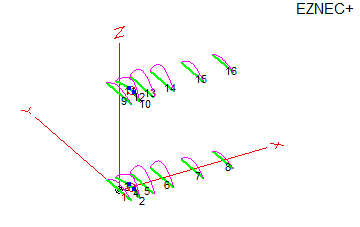

Plot and data of 4 vertically stacked GTV 2-6m using DL6WU stacking distances
Antenna View, Elevation & Azimuth Pattern

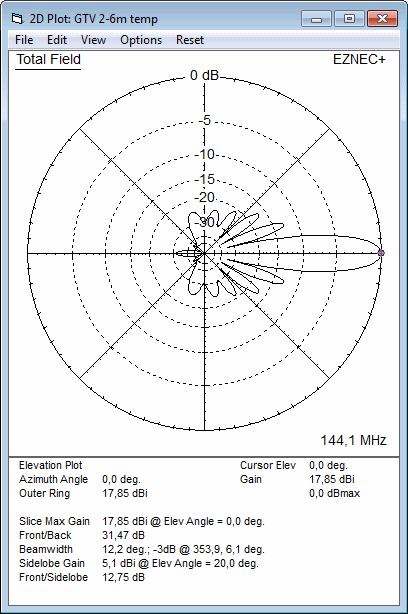
Plot and data of 4 bay of GTV 2-6m using DL6WU stacking distances
Elevation & Azimuth Pattern



AGTC_lite screenshot (Traditional Temps: Tsky = 200 K, Tearth = 1000 K)

AGTC_lite screenshot (Redefined Temps: Tsky = 287 K, Tearth = 5126 K acc. ITU)
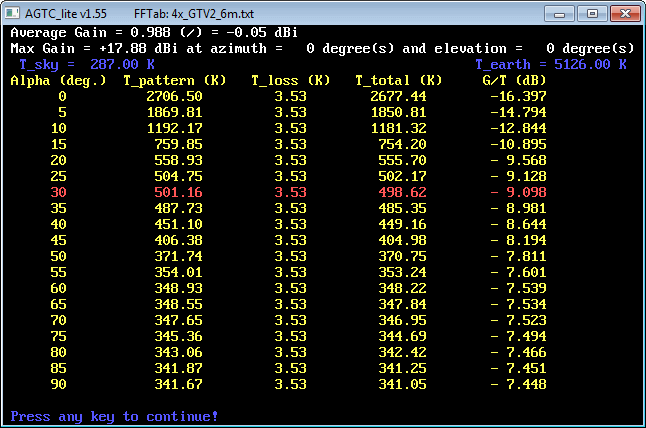
Gain vs. isotr. Rad. 17.9 dBi Gain vs. Dipole 15.7 dBD -3 dB H-plane 25.2 deg. -3 dB E-plane 20.6 deg. F/B -33.0 dB F/R -23.4 dB T_los 3.5 K T_ant 498.6 K* (236.1 K) G/T -9.10 dB* (-5.85 K)Theoretical numbers, no phasing line losses
nor imperfections caused by H-frame included
*) T_sky = 287 K, T_earth = 5126 K as in VE7BQH G/T table
16 x GTV 2-6m xpol ... 23.4 dBi: click to enlarge

146.5 MHz DATV Version of the GTV 2-6m
This is a scaled to 146.5 MHz version of the GTV 2-6m.
Element lengths and positions are adapted to 146.5 MHz.

Hence the Pattern is same as for the 144 MHz Version
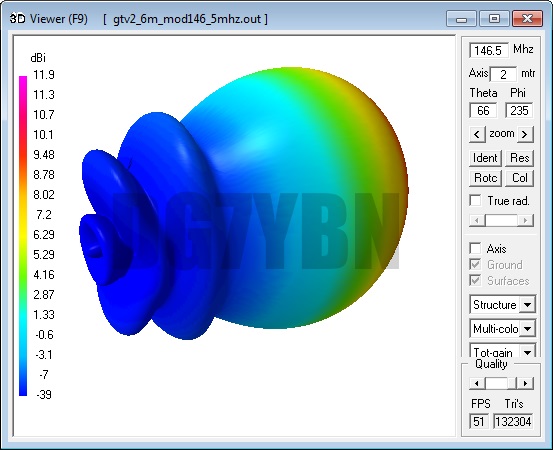
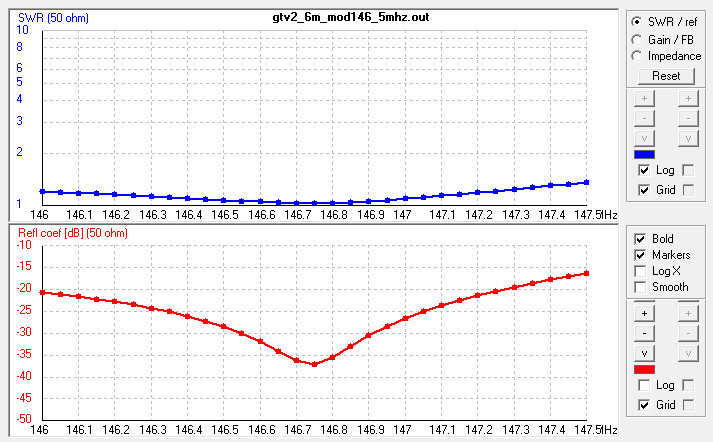
This Yagi with 8 mm elements on a 20 x 20 mm boom with standard insulators

|
Ele. 8.0 mm DE 10 mm Boom 20 x 20 mm |
"Ready to saw and drill" data for mounting elements on boom with BC according DG7YBN for standard insulators as sold by Konni, Nuxcom, WiMo, 7arrays:
Includes an SBC of 3.04 mm

This Yagi with 8 mm elements through a 25 x 25 x 1.5 mm boom

|
Ele. 8.0 mm DE 10.0 mm Boom 25 x 25 x 1.5 mm |
"Ready to saw and drill" data for mounting elements through boom with BC according SM5BSZ's BC.exe:
Note: with through Boom BC it is important to stick to the boom end offsets given below!
This table is only valid for:
Boom shape: square
Boom dim: 25 x 25 mm
Wall thickn.: 1.5 mm
Holes in boom: 10.0 mm
Offset rear: 40 mm
Offset front: 40 mm
Includes an SBC of 3.04 mm

Stacking Info 146.5 MHz DATV Version
Stacking Dist. h-pol.
top-to-bottom 2.16 m or 7.1 ft
side-by-side 2.61 m or 8.55 ft
73, Hartmut, DG7YBN
